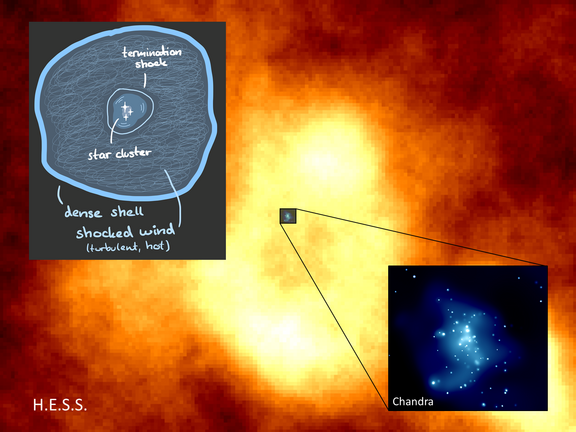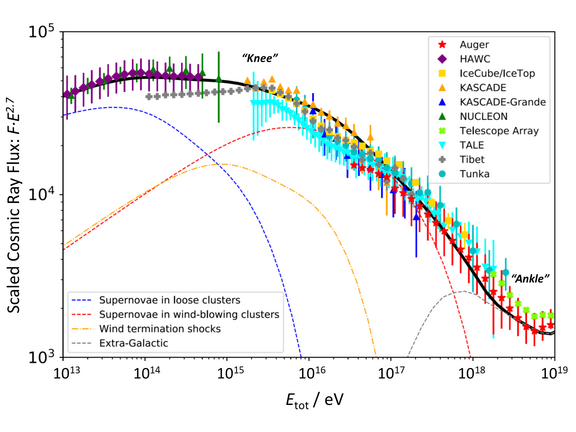Since their discovery more than 100 years ago cosmic rays, energetic particles from outer space, are subject of both astronomical observations as well as the theoretical approach to understand their origin. They continuously bombard our atmosphere and their energy spectrum stretches towards the highest values ever recorded – exceeding those generated in man-made accelerators by many orders of magnitude. For decades a number of dedicated experiments accumulated a depth of knowledge about cosmic rays, revealing crucial details in their energy spectrum and composition. However, due to deflection by magnetic fields, charged particles propagate on a random path towards Earth and the information about their origin is lost. The identification of the sources though can be retrieved with the help of gamma-ray astronomy, as these sources are likely to emit high-energy photons as well.
Though the origins of cosmic rays – within our Galaxy and elsewhere – remains the subject of speculation, the most widely accepted explanation is that cosmic rays are primarily accelerated at fast moving shocks, such as those occurring in supernova remnants. Theoretical studies model the underlying acceleration process in different scenarios, including the plasma physics and particle dynamics in and around their sources. The spectrum of cosmic rays extends up to 1021 electron volts (eV). The most extreme energies beyond 1018 (exa) eV are considered to be of extragalactic origin since they would not be confined by magnetic fields on the size scale of the Galaxy. While the lower part of the spectrum fits to the expectation based on supernova remnant acceleration mechanisms, the transition region around a few 100 peta-electron volts (PeV, 1015) is still puzzling.
A possible solution may be provided by considering collective effects in young rich stellar clusters, the nurseries of stars massive enough to end up in a supernova explosion. Fig. 1 depicts Westerlund 1, the most massive known young star cluster in the Galaxy, seen in very-high energy gamma light by the H.E.S.S. telescopes and in X-rays by the Chandra satellite. The way more extended gamma emission and its shell-like structure suggest a connection with the collective wind of the cluster forming a kind of superbubble as illustrated in the cartoon inset in Fig. 1: The stars in the core drive a collective supersonic wind, that terminates in a shock where the pressure of the wind reaches equilibrium with the confined, turbulent, shock-heated wind.
In order to compare this approach to existing cosmic ray data, Thibault Vieu and Brian Reville from the Astrophysical Plasma Theory group at the Max Planck Institute for Nuclear Physics in Heidelberg (MPIK) modelled two classes of massive star clusters: “loose” clusters that do not power a collective wind termination shock and young compact clusters, which are powerful and compact enough to sustain a collective wind outflow.
“Our aim was to compute the GCR spectrum, including this component due to particle acceleration around this special population of SNR shocks”, states postdoc Thibault Vieu. “First, we need to estimate the abundance of sources based on the galactic cluster census presented in the recent analysis of the Gaia Data Release 2. Then, we model the spectrum of particles accelerated by clustered supernovae. Finally, we consider the escaping spectra from a distribution of sources as well as the propagation of the cosmic rays within the Galaxy.”
The calculation of the all-particle spectrum contains overall 21 input parameters. Most of them are known mainly from independent sources and observations except five “fitting” parameters (including the overall normalization of the spectrum), which are allowed to vary within reasonable bounds. The fraction of massive stars in clusters is estimated to be 80% and among this population a fraction of about 15% wind blowing clusters .
The result is given in Fig. 2 in comparison with a compilation of recent data. The spectrum of cosmic rays follows a power law ∼E–γ which appears linear in a double logarithmic plot. Phenomenologically, there’s a change in the slope (i. e. the exponent) around 3 PeV known as the “knee” followed by the “ankle” at about 3 EeV. Both features indicate different components of the spectrum, the latter the transition to extragalactic origin. For better visibility, the spectral flux is scaled with E–2.7 (γ ≈ 2.7 below the knee). The calculation reproduces the spectrum of galactic cosmic rays well from TeV up to hundreds of PeV, where the extragalactic component is expected to take over. The knee of the CR spectrum turns out as a signature of the transition between the contribution from supernova remnant shocks in loose massive clusters and that of those expanding in the vicinity of young and compact wind-blowing clusters.
Group leader Brian Reville concludes: “The unique conditions in cluster environments may be favourable for cosmic-ray acceleration to the most extreme values that can be achieved in our Galaxy. The next generation of gamma-ray observatories like CTA will probe many such systems in unprecedented detail which, supported by theoretical predictions, may finally answer the century-old problem of the origin of galactic cosmic rays.”
Original publication:
Massive star cluster origin for the galactic cosmic ray population at very-high energies
T. Vieu and B. Reville
Monthly Notices of the Royal Astronomical Society, 519(1), 136-147 (2023), DOI: 10.1093/mnras/stac3469
Astrophysical Plasma Theory group at MPIK
Cherenkov Telescope Array (CTA)

